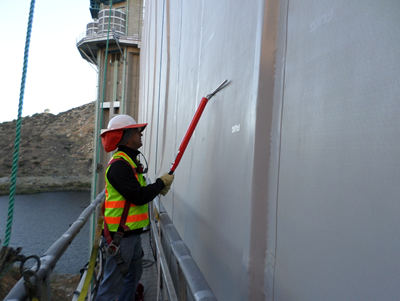
AUSTIN, Texas – After having been in commercial use in Europe since 1999, the arc testing electrical leak location (ELL) method has finally found a home among other electrical leak location methods in ASTM International’s standards system. ASTM D7953-14, Standard Practice for Electrical Leak Location on Exposed Geomembranes Using the Arc Testing Method, has been approved by Committee D35 on Geosynthetics.
“The arc testing method evolved from the spark testing method, but is quite a different technology,” says Abigail Beck, P.E., director of TRI Liner Integrity Services. Beck served as the technical contact on the standard for Subcommittee D35.10 on Geomembranes.
“Spark testing is specifically used for coextruded conductive-backed geomembrane, while the arc tester was specially designed to use natural materials (soil, clay, rock) as the conductive medium for the electrical path. While the spark tester uses a build-up of electrical potential to discharge discrete sparks, the arc tester maintains a continuous electrical arc,” she says.
TRI Liner Integrity Services is the American distributor for the arc testing equipment manufactured by Sensor and conducts the only liner integrity survey training courses currently available in the world.

These sessions allow current users to update their technologies and teams, while new users may sample equipment and gain support as they develop an ELL-related business line.
“The arc testing method has proven highly successful in projects throughout Europe, Asia, South America, Australia and North America,” says Beck. “More than five million square meters of area were surveyed between 2009 and 2014, and the enhanced sensitivity of the arc testing method located thousands of leaks in containment facilities that otherwise may have remained undetected.”
Of note, arc testing does not require the addition of water to carry the current for the electrical detection path, which can lower project costs and decrease strain on natural resources. The arc tester is also more amenable to testing extremely sloped or vertical surfaces and has been shown to better locate leaks near other conductive elements that may provide interference with other methods.
Supported by an ASTM standard, the international marketplace now has a full suite of electrical leak location methods to select from.
Visit www.linersurvey.com to learn more about these technologies, or contact Abigail Beck, abeck@tri-env.com.











